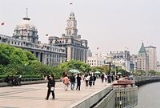
The Bund
Encyclopedia
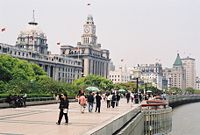

Shanghai
Shanghai is the largest city by population in China and the largest city proper in the world. It is one of the four province-level municipalities in the People's Republic of China, with a total population of over 23 million as of 2010...
, People's Republic of China
People's Republic of China
China , officially the People's Republic of China , is the most populous country in the world, with over 1.3 billion citizens. Located in East Asia, the country covers approximately 9.6 million square kilometres...
. The area centres on a section of Zhongshan Road (East-1 Zhongshan Road) within the former Shanghai International Settlement
Shanghai International Settlement
The Shanghai International Settlement began originally as a purely British settlement. It was one of the original five treaty ports which were established under the terms of the Treaty of Nanking at the end of the first opium war in the year 1842...
, which runs along the western bank of the Huangpu River
Huangpu River
The Huangpu River is a -long river in China flowing through Shanghai...
, facing Pudong
Pudong
Pudong |Bank]]") is an area of Shanghai, China, located along the east side of the Huangpu River, across from the historic city center of Shanghai in Puxi. Formerly a little-developed agricultural area linked only by ferries, Pudong has grown rapidly since the 1990s and emerged as China's financial...
, in the eastern part of Huangpu District
Huangpu District, Shanghai
Huangpu District , is one of Shanghai's 18 districts and makes up the eastern part of Shanghai's traditional urban core. Today's Huangpu District is sometimes referred to as "new Huangpu" to distinguish it from the pre-merger Huangpu District which existed before 2000. In 2000, the pre-merger...
. The Bund usually refers to the buildings and wharves on this section of the road, as well as some adjacent areas. It is one of the most famous tourist destinations in Shanghai. Building heights are restricted in this area.
Name
The word "bund" means an embankment or an embanked quay. The word comes from the Hindi-Urdu word band, which has Persian origins and meant an embankment, leveeLevee
A levee, levée, dike , embankment, floodbank or stopbank is an elongated naturally occurring ridge or artificially constructed fill or wall, which regulates water levels...
or dam (a cognate of English terms "bind", "bond" and "band", and the German word "Bund", etc). In Chinese port cities, the English term came to mean, especially, the embanked quay along the shore. In English, "Bund" is pronounced to rhyme with "fund".
There are numerous sites in India
India
India , officially the Republic of India , is a country in South Asia. It is the seventh-largest country by geographical area, the second-most populous country with over 1.2 billion people, and the most populous democracy in the world...
, China
China
Chinese civilization may refer to:* China for more general discussion of the country.* Chinese culture* Greater China, the transnational community of ethnic Chinese.* History of China* Sinosphere, the area historically affected by Chinese culture...
, and Japan
Japan
Japan is an island nation in East Asia. Located in the Pacific Ocean, it lies to the east of the Sea of Japan, China, North Korea, South Korea and Russia, stretching from the Sea of Okhotsk in the north to the East China Sea and Taiwan in the south...
which are called "bunds" (e.g. the Yokohama Bund). However, "The Bund" as a proper noun almost invariably refers to this stretch of embanked riverfront in Shanghai
Shanghai
Shanghai is the largest city by population in China and the largest city proper in the world. It is one of the four province-level municipalities in the People's Republic of China, with a total population of over 23 million as of 2010...
.
History
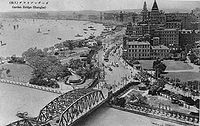

.jpg)
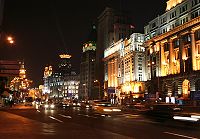
United Kingdom
The United Kingdom of Great Britain and Northern IrelandIn the United Kingdom and Dependencies, other languages have been officially recognised as legitimate autochthonous languages under the European Charter for Regional or Minority Languages...
, France
France
The French Republic , The French Republic , The French Republic , (commonly known as France , is a unitary semi-presidential republic in Western Europe with several overseas territories and islands located on other continents and in the Indian, Pacific, and Atlantic oceans. Metropolitan France...
, the United States
United States
The United States of America is a federal constitutional republic comprising fifty states and a federal district...
, Italy
Italy
Italy , officially the Italian Republic languages]] under the European Charter for Regional or Minority Languages. In each of these, Italy's official name is as follows:;;;;;;;;), is a unitary parliamentary republic in South-Central Europe. To the north it borders France, Switzerland, Austria and...
, Russia
Russia
Russia or , officially known as both Russia and the Russian Federation , is a country in northern Eurasia. It is a federal semi-presidential republic, comprising 83 federal subjects...
, Germany
Germany
Germany , officially the Federal Republic of Germany , is a federal parliamentary republic in Europe. The country consists of 16 states while the capital and largest city is Berlin. Germany covers an area of 357,021 km2 and has a largely temperate seasonal climate...
, Japan
Japan
Japan is an island nation in East Asia. Located in the Pacific Ocean, it lies to the east of the Sea of Japan, China, North Korea, South Korea and Russia, stretching from the Sea of Okhotsk in the north to the East China Sea and Taiwan in the south...
, the Netherlands
Netherlands
The Netherlands is a constituent country of the Kingdom of the Netherlands, located mainly in North-West Europe and with several islands in the Caribbean. Mainland Netherlands borders the North Sea to the north and west, Belgium to the south, and Germany to the east, and shares maritime borders...
and Belgium
Belgium
Belgium , officially the Kingdom of Belgium, is a federal state in Western Europe. It is a founding member of the European Union and hosts the EU's headquarters, and those of several other major international organisations such as NATO.Belgium is also a member of, or affiliated to, many...
, as well as the consulates of Russia
Consulate-General of Russia in Shanghai
The Consulate-General of the Russian Federation in Shanghai is the diplomatic mission of Russia in Shanghai. It is located at 20 Huangpu Road on The Bund in Shanghai, next to the Garden Bridge near the convergence of the Suzhou and Huangpu rivers, and across the road from the Astor House Hotel...
and Britain, a newspaper, the Shanghai Club and the Masonic Club. The Bund lies north of the old, walled city of Shanghai. This was initially a British settlement; later the British and American settlements were combined in the International Settlement
Shanghai International Settlement
The Shanghai International Settlement began originally as a purely British settlement. It was one of the original five treaty ports which were established under the terms of the Treaty of Nanking at the end of the first opium war in the year 1842...
. A building boom at the end of 19th century and beginning of 20th century led to the Bund becoming a major financial hub of East Asia
East Asia
East Asia or Eastern Asia is a subregion of Asia that can be defined in either geographical or cultural terms...
. The former French Bund, east of the walled city was formerly more a working harbourside.
By the 1940s the Bund housed the headquarters of many, if not most, of the major financial institutions operating in China, including the "big four" national banks in the Republic of China
Republic of China
The Republic of China , commonly known as Taiwan , is a unitary sovereign state located in East Asia. Originally based in mainland China, the Republic of China currently governs the island of Taiwan , which forms over 99% of its current territory, as well as Penghu, Kinmen, Matsu and other minor...
era. However, with the Communist victory in the Chinese civil war
Chinese Civil War
The Chinese Civil War was a civil war fought between the Kuomintang , the governing party of the Republic of China, and the Communist Party of China , for the control of China which eventually led to China's division into two Chinas, Republic of China and People's Republic of...
, many of the financial institutions were moved out gradually in the 1950s, and the hotels and clubs closed or converted to other uses. The statues of colonial figures and foreign worthies which had dotted the riverside were also removed.
In the late 1970s and early 1980s, with the thawing of economic policy in the People's Republic of China
People's Republic of China
China , officially the People's Republic of China , is the most populous country in the world, with over 1.3 billion citizens. Located in East Asia, the country covers approximately 9.6 million square kilometres...
, buildings on the Bund were gradually returned to their former uses. Government institutions were moved out in favour of financial institutions, while hotels resumed trading as such. Also during this period, a series of floods caused by typhoons motivated the municipal government to construct a tall levee along the riverfront, with the result that the embankment now stands some 10 metres higher than street level. This has dramatically changed the streetscape of the Bund. In the 1990s, Zhongshan Road (named after Sun Yat-sen
Sun Yat-sen
Sun Yat-sen was a Chinese doctor, revolutionary and political leader. As the foremost pioneer of Nationalist China, Sun is frequently referred to as the "Father of the Nation" , a view agreed upon by both the People's Republic of China and the Republic of China...
), the road on which the Bund is centred, was widened to ten lanes. As a result, most of the parkland which had existed along the road disappeared. Also in this period, the ferry wharves connecting the Bund and Pudong
Pudong
Pudong |Bank]]") is an area of Shanghai, China, located along the east side of the Huangpu River, across from the historic city center of Shanghai in Puxi. Formerly a little-developed agricultural area linked only by ferries, Pudong has grown rapidly since the 1990s and emerged as China's financial...
, which had served the area's original purpose, were removed. A number of pleasure cruises still operate from some nearby wharves.
In the 1990s the Shanghai government attempted to promote an extended concept of the Bund to boost tourism, and land value in nearby areas, as well as to reconcile the promotion of "colonial relics" with the Socialist ideology. In its expanded form, the term "Bund" (as "New Bund" or "Northern Bund") was used to refer to areas south of the Yan'an Road, and a stretch of riverfront north of the Suzhou River (Zhabei). Such use of the term, however, remains rare outside of the tourism literature.
From 2008, a major reconfiguration of traffic flow along the Bund was carried out. The first stage of the plan involved the southern end of the Bund, and saw the demolition of a section of the Yan'an Road elevated expressway, which will remove the large elevated expressway exit structure which formerly dominated the confluence of Yan'an Road and the Bund. The second stage, begun on 1 March 2008, involves the complete restoration of the century-old Waibaidu Bridge
Waibaidu Bridge
The Waibaidu Bridge , called The Garden Bridge in English, is the first all-steel bridge, and the only surviving example of a camelback truss bridge, in China...
at the northern end of the Bund. The restoration is expected to be completed by early 2009. The next stage of the plan involves a reconstruction of the Bund roadway. The current 8-lane roadway will be rebuilt as in two levels, with four lanes on each level. This will allow part of the Bund road space to be restored to its former use as parkland and marginal lawns. The new concrete bridge that was built in 1991 to relieve traffic on Waibaidu Bridge will also be rendered obsolete by the new double-levelled roadway, and will be demolished.
The Bund was re-opened to the public on Sunday 28 March 2010 after restoration.
Layout
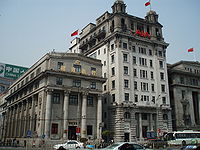
Waibaidu Bridge
The Waibaidu Bridge , called The Garden Bridge in English, is the first all-steel bridge, and the only surviving example of a camelback truss bridge, in China...
(formerly Garden Bridge) in the north, which crosses Suzhou Creek
Suzhou Creek
Suzhou Creek is a river in China that passes through the Shanghai city centre. It is named after Suzhou, a city in neighbouring Jiangsu province which was the predominant city in this area prior to the rise of Shanghai as a metropolis.One of the principal outlets of Lake Tai, Suzhou Creek has a...
.
The Bund centres on a stretch of the Zhongshan Road
Zhongshan Road
Zhongshan, Jhongshan or Chung Shan is a common name of Chinese roads, usually in honour of Sun Yat-sen, better-known in Chinese as "Sun Zhongshan", who is considered by many to be the "Father of modern China"....
, named after Sun Yat-sen
Sun Yat-sen
Sun Yat-sen was a Chinese doctor, revolutionary and political leader. As the foremost pioneer of Nationalist China, Sun is frequently referred to as the "Father of the Nation" , a view agreed upon by both the People's Republic of China and the Republic of China...
. Zhongshan Road is a largely circular road which formed the traditional conceptual boundary of Shanghai city "proper". To the west of this stretch of the road stands some 52 buildings of various Western classical and modern styles which is the main feature of the Bund (see Architecture and buildings below). To the east of the road was formerly a stretch of parkland culminating at Huangpu Park
Huangpu Park
Huangpu Park is the name of the triangular stretch of green at the northern end of the Bund in Shanghai, the oldest and smallest park of the city...
. (This park is the site of the infamous sign reported to have proclaimed "no dogs or Chinese", although this exact wording never existed. Further information, including an image of the sign, can be found at the article on Huangpu Park
Huangpu Park
Huangpu Park is the name of the triangular stretch of green at the northern end of the Bund in Shanghai, the oldest and smallest park of the city...
.) This area is now much reduced due to the expansion of Zhongshan Road. Further east is a tall levee, constructed in the 1990s to ward off flood waters. The construction of this high wall has dramatically changed the appearance of the Bund.
Near the Nanjing Road intersection stands what is currently the only bronze statue along the Bund. It is a statue of Chen Yi
Chen Yi (communist)
Chen Yi was a Chinese communist military commander and politician. He served as the 2nd Mayor of Shanghai and the 2nd Foreign Minister of China.-Biography:Chen was born in Lezhi, near Chengdu, Sichuan, into a moderately wealthy magistrate's family....
, the first Communist mayor of Shanghai. At the northern end of The Bund, along the riverfront, is Huangpu Park
Huangpu Park
Huangpu Park is the name of the triangular stretch of green at the northern end of the Bund in Shanghai, the oldest and smallest park of the city...
, in which is situated the Monument to the People's Heroes
Monument to the People's Heroes (Shanghai)
The Monument to the People's Heroes is a concrete structure in Shanghai, China. The structure is located at the confluence of the Suzhou Creek and the Huangpu River, within the grounds of the Huangpu Park....
- a tall, abstract concrete tower which is a memorial for the those who died during the revolutionary struggle of Shanghai dating back to the First Opium War
First Opium War
The First Anglo-Chinese War , known popularly as the First Opium War or simply the Opium War, was fought between the United Kingdom and the Qing Dynasty of China over their conflicting viewpoints on diplomatic relations, trade, and the administration of justice...
.
Architecture and buildings


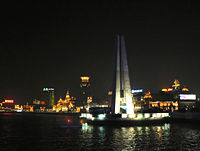

Romanesque architecture
Romanesque architecture is an architectural style of Medieval Europe characterised by semi-circular arches. There is no consensus for the beginning date of the Romanesque architecture, with proposals ranging from the 6th to the 10th century. It developed in the 12th century into the Gothic style,...
, Gothic
Gothic architecture
Gothic architecture is a style of architecture that flourished during the high and late medieval period. It evolved from Romanesque architecture and was succeeded by Renaissance architecture....
, Renaissance
Renaissance architecture
Renaissance architecture is the architecture of the period between the early 15th and early 17th centuries in different regions of Europe, demonstrating a conscious revival and development of certain elements of ancient Greek and Roman thought and material culture. Stylistically, Renaissance...
, Baroque
Baroque architecture
Baroque architecture is a term used to describe the building style of the Baroque era, begun in late sixteenth century Italy, that took the Roman vocabulary of Renaissance architecture and used it in a new rhetorical and theatrical fashion, often to express the triumph of the Catholic Church and...
, Neo-Classical
Neoclassical architecture
Neoclassical architecture was an architectural style produced by the neoclassical movement that began in the mid-18th century, manifested both in its details as a reaction against the Rococo style of naturalistic ornament, and in its architectural formulas as an outgrowth of some classicizing...
, Beaux-Arts, and Art Deco
Art Deco
Art deco , or deco, is an eclectic artistic and design style that began in Paris in the 1920s and flourished internationally throughout the 1930s, into the World War II era. The style influenced all areas of design, including architecture and interior design, industrial design, fashion and...
(Shanghai has one of the richest collections of Art Deco
Art Deco
Art deco , or deco, is an eclectic artistic and design style that began in Paris in the 1920s and flourished internationally throughout the 1930s, into the World War II era. The style influenced all areas of design, including architecture and interior design, industrial design, fashion and...
architectures in the world). From the south, the main buildings are:
- Asia BuildingAsia Building, ShanghaiThe six-storey Asia Building , also known as Mc Bain or Asiatic Petroleum building, is on the Bund in the Chinese city of Shanghai. It was built in 1916 for Royal Dutch Shell's Asiatic Petroleum division and later housed the Shanghai Metallurgical Designing & Research Institute.- References :* *...
(No. 1, The Bund), originally the McBain Building, housed the Shanghai offices of Royal Dutch ShellRoyal Dutch ShellRoyal Dutch Shell plc , commonly known as Shell, is a global oil and gas company headquartered in The Hague, Netherlands and with its registered office in London, United Kingdom. It is the fifth-largest company in the world according to a composite measure by Forbes magazine and one of the six...
and Asiatic Petroleum CompanyAsiatic Petroleum CompanyAsiatic Petroleum Company was a joint venture between the Shell and Royal Dutch oil companies founded in 1903. It operated in Asia in the early twentieth century. The corporate headquarters were on The Bund in Shanghai, China. The division tested the limits of corporate liability in the Lennard's...
. - Shanghai ClubShanghai Club BuildingThe Shanghai Club Building is a three-storey Baroque Revival building in Shanghai along The Bund. The club was originally named 'The Correspondent's Club'. It is currently part of the Waldorf-Astoria Hotel.-Structure:...
(No. 2, The Bund), which was the principal social club for British nationals in Shanghai. Since 2010 the Waldorf-Astoria Shanghai Hotel. - Union BuildingUnion Building, ShanghaiThe Union Building is a building on the Bund in Shanghai, China. It is located at No. 3, the Bund .Completed in 1916, the building was used by a number of insurance companies. The six-storey building was the first work in Shanghai of P&T Architects and Surveyors , and was the first building in...
(No. 3, The Bund), housed a number of insurance companies. - The Mercantile Bank of India, London, and China building (No. 4, The Bund), housed the Mercantile Bank of India, London and ChinaMercantile Bank of India, London and ChinaThe Mercantile Bank of India, London and China was an Anglo-Indian with business focus in the Far East.-History:The bank was established in October 1853 in Bombay , but its headquarters moved to London in 1858...
, built between 1916-1918. - Nissin Building (No. 5, The Bund), housed a Japanese shipping company.
- China Merchants Bank BuildingChina Merchants Bank Building, ShanghaiThe four story China Merchants Bank Building in Shanghai was built in 1907 and later Hospital of Shanghai Changjiang Navigation Company.-References:*...
(No. 6, The Bund), housed the first Chinese-owned bank in China is now Shiatzy ChenShiatzy ChenShiatzy Chen is a Taiwanese fashion house, whose founder and brand innovator Wang Chen Tsai-Hsia is often referred to as the Chanel of Taiwan,and is the eponym of her luxury goods brand. She was born in 1951 in Changhua, Taiwan and founded the company in 1978...
’s Shanghai flagship store,which opened in October 2005. - The Great Northern Telegraph Corporation BuildingGreat Northern Telegraph CompanyThe Great Northern Telegraph Company was a Danish telegraph company founded in June 1869...
(No. 7, The Bund), housed Great Northern Telegraph CompanyGreat Northern Telegraph CompanyThe Great Northern Telegraph Company was a Danish telegraph company founded in June 1869...
. Site of the first telephone switch in Shanghai in 1882. - Russel & Co. Building (No. 9, The Bund), now houses the China Shipping Merchant Company.
- The HSBC BuildingHSBC Building, ShanghaiThe HSBC Building is a six-floor neo-classical building in the Bund area of Shanghai, China. It was the headquarters of the Shanghai branch of The Hongkong and Shanghai Banking Corporation from 1923 to 1955. The building is situated at number 12, the Bund. It is also known as the Municipal...
(No. 12, The Bund), now used by the Shanghai Pudong Development BankShanghai Pudong Development BankShanghai Pudong Development Bank Co. Ltd , incorporated on January 9, 1993 with the approval of the People's Bank of China , is a joint-stock commercial bank with its headquarters located in Shanghai....
, was once the Shanghai headquarters of the Hongkong and Shanghai Banking CorporationHongkong and Shanghai Banking CorporationThe Hongkong and Shanghai Banking Corporation Limited is a prominent bank established and based in Hong Kong since 1865 when Hong Kong was a colony of the British Empire. It is the founding member of the HSBC Group and since 1990 is now a wholly owned subsidiary of HSBC Holdings plc...
, which failed to reach a deal with the Shanghai government to buy the building again in the 1990s, when the Shanghai government moved out of the building that they had used since the 1950s. The present building was completed in 1923. At the time, it was called "the most luxurious building between the Suez Canal and the Bering Strait". Its famous ceiling mosaics have been fully restored, and can be viewed inside the entrance hall. - The Customs HouseCustoms House, ShanghaiThe Customs House is an eight storey building on the Bund, Shanghai. Built in 1927, the building remains a customs house today. Together with the neighbouring HSBC Building, the Customs House is seen as one of the symbols of the Bund and Shanghai.-History:The Shanghai Customs House was first set...
(No. 13, The Bund), was built in 1927 on the site of an earlier, traditional Chinese-style customs house. The clock and bell was built in England and in imitation of Big Ben. - China Bank of Communications Building (No. 14, The Bund), was the last building to be built on the Bund. It now houses the Shanghai Council of Trade Unions.
- Russo-Chinese Bank BuildingRusso-Chinese Bank Building, ShanghaiThe St. Petersburg Russo-Asiatic Bank. Renamed Central Building in 1928. It was designed by German architects Becker & Baedecker and built between 1901-1905 of brick and concrete composite structure. It is the earliest building equipped with tile facing, lifts, and sanitary facilities in...
(No. 15, The Bund) is now the Shanghai Foreign Exchange. - Bank of Taiwan Building (No. 16, The Bund) is now the China Merchants Bank.
- North China Daily News BuildingNorth China Daily News BuildingNorth China Daily News Building is a historical Neo-Renaissance-style office building on the Bund in Shanghai, China. It is located at Number 17, East Zhongshan No.1 Road, and houses the offices of the American International Assurance and is thus often called the AIA Building...
(No. 17, The Bund) housed the most influential English-language newspaper in Shanghai at the time. Today it houses AIA Insurance. - Chartered Bank Building (No. 18, The Bund) housed the Shanghai headquarters of what became Standard Chartered BankStandard Chartered BankStandard Chartered PLC is a multinational financial services company headquartered in London, United Kingdom with operations in more than seventy countries...
the building now houses designer shops and a creative exhibition space. - Palace HotelPeace HotelThe Peace Hotel is a hotel on The Bund in Shanghai, China which overlooks the Huangpu River. The hotel today operates as two separate businesses. The North Building, built as Sassoon House, originally housed the Cathay Hotel and is today the Fairmont Peace Hotel run by Fairmont Hotel and Resorts...
(No. 19, The Bund), today forms part of the Peace HotelPeace HotelThe Peace Hotel is a hotel on The Bund in Shanghai, China which overlooks the Huangpu River. The hotel today operates as two separate businesses. The North Building, built as Sassoon House, originally housed the Cathay Hotel and is today the Fairmont Peace Hotel run by Fairmont Hotel and Resorts...
. - Sassoon HousePeace HotelThe Peace Hotel is a hotel on The Bund in Shanghai, China which overlooks the Huangpu River. The hotel today operates as two separate businesses. The North Building, built as Sassoon House, originally housed the Cathay Hotel and is today the Fairmont Peace Hotel run by Fairmont Hotel and Resorts...
(No. 20, The Bund), with the attached Cathay Hotel, was built by Sir Victor SassoonVictor SassoonSir Ellice "Victor" Sassoon, 3rd Baronet, GBE was a businessman and hotelier from the Sassoon banking family. He succeeded to the Baronetcy on the death of his father Edward Elias Sassoon in 1924...
. It was, and still is today, famous for its jazzJazzJazz is a musical style that originated at the beginning of the 20th century in African American communities in the Southern United States. It was born out of a mix of African and European music traditions. From its early development until the present, jazz has incorporated music from 19th and 20th...
band in its cafe. The top floor originally housed Sassoon's private apartment. Today, it forms the other part of the Peace HotelPeace HotelThe Peace Hotel is a hotel on The Bund in Shanghai, China which overlooks the Huangpu River. The hotel today operates as two separate businesses. The North Building, built as Sassoon House, originally housed the Cathay Hotel and is today the Fairmont Peace Hotel run by Fairmont Hotel and Resorts...
. - Bank of China BuildingOld Bank of China Building, ShanghaiThe Bank of China Building is a tower located at No. 23 on the Bund, in Shanghai, People's Republic of China. Previously the headquarters of the Bank of China, it now houses the Shanghai Branch of the Bank of China....
(No. 23, The Bund) housed the headquarters of the Bank of ChinaBank of ChinaBank of China Limited is one of the big four state-owned commercial banks of the People's Republic of China. It was founded in 1912 by the Government of the Republic of China, to replace the Government Bank of Imperial China. It is the oldest bank in China...
. The stunted appearance of the building is attributed to Sassoon's insistence that no other building on the Bund could rise higher than his. - Yokohama Specie Bank BuildingYokohama Specie Bank Building, ShanghaiThe Yokohama Specie Bank Building, now Shanghai Textile Holding Corporation, is a seven-floor building in the Chinese city of Shanghai and was completed in the 1920s. It was built by architects P & T Architects & Engineers Ltd. ....
(No. 24, The Bund) housed the Japanese Yokohama Specie Bank. - 'Yangtsze Insurance Association Building (No. 26, The Bund) Today houses the a Shanghai branch of the Agricultural Bank of China.
- Jardine Matheson Building (No. 27, The Bund) housed the then-powerful Jardine Matheson companyJardine Matheson HoldingsJardine Matheson Holdings Limited often referred to as Jardines, is a multinational corporation incorporated in Bermuda and based in Hong Kong. While listed on the London Stock Exchange and the Singapore Exchange, the vast majority of Jardines shares are traded in Singapore...
. - Glen Line Building (No. 2 Beijing Road) today houses the Shanghai Broadcasting Board.
- Banque de l'Indochine Building (No. 29, The Bund) housed the French bank, Banque de l'IndochineBanque de l'IndochineThe Banque de l'Indochine was a minting and banknote-issuing bank established in Paris on January 21, 1875, for the territories of France in Asia.-History:...
. - Consulate-General of the United KingdomFormer Consulate-General of the United Kingdom, ShanghaiThe Former Consulate-General of the United Kingdom building located in Shanghai, China, is one of the oldest buildings on The Bund.It is housed in a compound that housed a number of buildings used by the British Consulate-General....
(No. 33, The Bund) housed the Consulate-General of the United KingdomUnited KingdomThe United Kingdom of Great Britain and Northern IrelandIn the United Kingdom and Dependencies, other languages have been officially recognised as legitimate autochthonous languages under the European Charter for Regional or Minority Languages...
. The building has been renovated and in 2010 re-opened as No 1 Waitanyuan, a private dining facility for government. Part of the site has also been used to build the Peninsula Hotel, Shanghai which opened in 2010.
Transport
While Shanghai Metro Line 2Shanghai Metro Line 2
Line 2 forms the east-west axis of the Shanghai metro network, intersecting with the north-south axis Line 1 at People's Square. With a length of nearly 64 km, it is the longest line in the metro system. Line 2 runs from Xujing East in the west to Pudong International Airport in the east,...
crosses the Bund, there are no plans to build a station on the Bund. The closest station is East Nanjing Road, about a five minute walk up Nanjing Road. East-1 Zhongshan Road is a major bus route.
There were previously frequent ferry services operating from wharves on and near the Bund. Some of these have been discontinued in the last decade, although pleasure cruises continue to operate from these wharves.

Cultural references
The Bund was famously featured in the novel Empire of the SunEmpire of the Sun
Empire of the Sun is a 1984 novel by J. G. Ballard which was awarded the James Tait Black Memorial Prize. Like Ballard's earlier short story, "The Dead Time" , it is essentially fiction but draws extensively on Ballard's experiences in World War II...
by British
United Kingdom
The United Kingdom of Great Britain and Northern IrelandIn the United Kingdom and Dependencies, other languages have been officially recognised as legitimate autochthonous languages under the European Charter for Regional or Minority Languages...
author J.G. Ballard, based on his experiences as a boy during the Japanese invasion and occupation. The book was later made into a film
Empire of the Sun (film)
Empire of the Sun is a 1987 American coming of age war film based on J. G. Ballard's semi-autobiographical novel of the same name. Steven Spielberg directed the film, which stars Christian Bale, John Malkovich, Miranda Richardson, and Nigel Havers...
by Steven Spielberg
Steven Spielberg
Steven Allan Spielberg KBE is an American film director, screenwriter, producer, video game designer, and studio entrepreneur. In a career of more than four decades, Spielberg's films have covered many themes and genres. Spielberg's early science-fiction and adventure films were seen as an...
.
The opening pages of the novel Cryptonomicon
Cryptonomicon
Cryptonomicon is a 1999 novel by American author Neal Stephenson. The novel follows the exploits of two groups of people in two different time periods, presented in alternating chapters...
by Neal Stephenson
Neal Stephenson
Neal Town Stephenson is an American writer known for his works of speculative fiction.Difficult to categorize, his novels have been variously referred to as science fiction, historical fiction, cyberpunk, and postcyberpunk...
are set on the Bund in November 1941, as civil order collapses under the threat of Japanese invasion.
The Bund is a setting (and namesake) of the Hong Kong
Hong Kong
Hong Kong is one of two Special Administrative Regions of the People's Republic of China , the other being Macau. A city-state situated on China's south coast and enclosed by the Pearl River Delta and South China Sea, it is renowned for its expansive skyline and deep natural harbour...
television series The Bund (1980) and film Shanghai Grand
Shanghai Grand
Shanghai Grand, also known as Shanghai Grand 1996 to differentiate this film from the more illustrious television series of the same Chinese title, The Bund , is a 1996 Hong Kong film directed by Poon Man-kit and starring Andy Lau, Leslie Cheung and Ning Jing.This film was directed by Poon Man-kit...
(1996). The story of both involve pre-World War II
World War II
World War II, or the Second World War , was a global conflict lasting from 1939 to 1945, involving most of the world's nations—including all of the great powers—eventually forming two opposing military alliances: the Allies and the Axis...
era gangsters competing for control of the Bund.
"The Bund" is a song composed by electronic music
Electronic music
Electronic music is music that employs electronic musical instruments and electronic music technology in its production. In general a distinction can be made between sound produced using electromechanical means and that produced using electronic technology. Examples of electromechanical sound...
group The Shanghai Restoration Project released on the group's first eponymous release, inspired by the Shanghai jazz bands of the 1930s. An instrumental
Instrumental
An instrumental is a musical composition or recording without lyrics or singing, although it might include some non-articulate vocal input; the music is primarily or exclusively produced by musical instruments....
version of the song titled "The Bund (Instrumental)" was released in 2008 on the group's Day - Night (Instrumentals) album.

